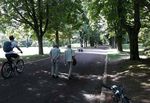GreenEquityHEALTH Factsheet II: The Value of Urban Parks for Health and Wellbeing.
←
→
Page content transcription
If your browser does not render page correctly, please read the page content below
GreenEquityHEALTH
Factsheet II:
The Value of Urban Parks for Health and Wellbeing.
Background
Urban green spaces provide a number of summer heat and drought periods in two
ecosystem services that are helpful to address distinct urban parks in Leipzig, Germany, using
challenges related to climate change and a interdisciplinary, multi-method approach.
urbanisation. Urban vegetation regulates the
In detail, the objectives were to
microclimate and air quality. Green spaces
• generate empirical evidence on the potential
promote physical activity, relaxation and social
of urban parks to provide cooling under the
interaction and thus, are beneficial for health
heat and drought conditions in 2018 and
and wellbeing. The potential to provide these
2019,
services might be impaired during extreme
• explore physical activity patterns related to
climatic conditions and weather events such as
divers park characteristics under the heat
heat waves and droughts.
and drought conditions in 2018 and
The GreenEquityHEALTH-project explored • analyse analyse physical and mental health
ecosystem services provision during recent effects related o park visits.
Friedenspark in July 2019 Friedenspark in June 2019 Lene-Voigt-Park in July 2018
www.greenequityhealth.hu-berlin.dePotential of urban parks to provide cooling during the heatwave Increasing daily maximum air temperatures were measured in mid July 2018 illustrating the gradual heating-up of the urban landscape during the heatwave. The hottest day air temperatures were observed with 33.5 °C (2 m height) and nearly 40 °C above ground in the Lene-Voigt-Park. Mean air temperatures were slightly higher in the Lene-Voigt-Park than in the Friedenspark attributable to different vegetation and surface structures. The Friedenspark features high total vegetation cover (96%) with mature trees providing shading during the day and evapotranspiration at day and night time. Tree vegetation cover in the Lene-Voigt-Park is only about 15% and unvegetated open space is evident with ca. 20% of total area. In addition, major ground vegetation on lawns was severely impacted by the drought conditions. Vast open space in Lene-Voigt-Park promotes, however, vertical heat flux from the surface providing cooling over night. Temperature trend in 2m and 0m height in the Friedenspark and Lene-Voigt-Park during field campaign in July 2018 (adapted from Kabisch and Kraemer, 2020). Permanent sensor stations in Friedenspark (left) and Lene-Voigt-Park (right) measuring air temperature, air humidity and soil temperature and humidity.
Physical activity patterns related to divers park characteristics under heat and drought conditions Active physical activities were observed on sports areas (basketball, soccer, streetball, football, beach volleyball) particularly in the Lene-Voigt-Park. In this park, sports areas are available majorily compared to the Friedenspark. Visitors jogging in the park were observed in higher numbers in the Friedenspark probably because of its bigger size and higher share of shaded space. Significantly lower numbers of joggers were observed with temperatures of 29.5°C or higher. Passive activities were observed on lawn areas and on benches for sunbathing, relaxing or talking with others during the day, particularly during lunch time and later in the afternoon and evening. Friedenspark in July 2019 Friedenspark in June 2019 Lene-Voigt-Park in July 2018 Lene-Voigt-Park in July 2019 Physical and mental health effects related to park visits In summer 2019, the GreenEquityHEALTH-team investigated the effects of short-term exposure of older people to divers urban parks and a busy street environment on physiological and psychological parameters. Heart rate variability, blood pressure, mood and perceived outcomes of restoration were measured in a sample of 33 older men and women (mean age 63.5). Results indicate decreases in systolic blood pressure and pulse pressure in the Friedenspark which indicate protective effects for cardiovascular health. By contrast, in the busy urban street area adverse changes of heart rate variability were found pointing to detrimental effects on cardiovascular health in this environment. Naturalness and restoration experience were rated highest in the older Friedenspark. Hence, visiting urban parks should be considered as an important preventive measure for promoting cardiovascular health. Entrance of Friedenspark in July 2019 Lene-Voigt-Park in July 2019
Team:
Nadja Kabisch, Roland Krämer, Jan Hemmerling, Oskar Masztalerz,
Marion Adam, Miriam Brenck*, Catharina Püffel*, Judith Rakowski*,
Peer von Döhren*, Dagmar Wörister
Acknowledgement
Project duration: 08/2017-07/2022
Project funder: Federal Ministry of Education and Research - BMBF
Funding code: 01LN1705A
Project management agency: German Aerospace Center - DLR
Advisory Board: Dagmar Haase (HUB), Jan Bumberger (UFZ),
Angela Lausch (UFZ), Matthias Braubach (WHO), Matilda van den Bosch
(UBC), Chantal van Ham (IUCN), Thomas Elmqvist (SRC)
This document is licensed under a Creative Commons Attribution 4.0
International License (http://creativecommons.org/licenses/by/4.0/).
Citation:
GreenEquityHEALTH (2020): Factsheet II - The value of Urban Parks for Health and Wellbeing.
*Former employees
www.greenequityhealth.hu-berlin.de
nadja.kabisch@geo.hu-berlin.de
Publications
Kabisch, N., & Kraemer, R. (2020). Physical activity patterns in two differently characterised urban parks
under conditions of summer heat. Environmental Science & Policy, 107, 56–65.
https://doi.org/10.1016/j.envsci.2020.02.008
Kabisch, N. (2019) Transformation of urban brownfields through co-creation: The multi-functional Lene-
Voigt Park in Leipzig as a case in point. Journal of Urban Transformations. Springer, 10.1186/s42854-
019-0002 https://doi.org/10.1186/s42854-019-0002-6
Kabisch, N., Alonso, L., Dadvand, P., Van den Bosch, M. (2019) Urban natural environments and motor
development in early life. https://doi.org/10.1016/j.envres.2019.108774
Kabisch, N., Haase, D., Haase, A. (2019) Reurbanisation: A long-term process or a short-term stage?
https://doi.org/10.1002/psp.2266
Kabisch, N., Selsam, P., Kirsten, T., Lausch, A., Bumberger, J. (2019) A multi-sensor and multi-temporal
remote sensing approach to detect land cover change dynamics in heterogeneous urban landscapes.
Ecological Indicators 99, 273-282 https://doi.org/10.1016/j.ecolind.2018.12.033
Kabisch, N., Haase, D. (2018) Urban nature benefits - Opportunities for improvement of health and well-
being in times of global change. 29th WHO Newsletter on Housing and Health “Urban Environmental
Health” accessible here: https://www.gesundheitsamt-bw.de/lga/DE/Fachinformationen/Infodienste_
Newsletter/WHOCC/Documents/No_29_2018-2_Urban_Environmental_Health.pdf
Kabisch, N., van den Bosch, M., Lafortezza, R. (2017) The health benefits of nature-based solutions to
urbanization challenges for children and the elderly - A systematic review. Environmental Research
159,pp.362-373. https://doi.org/10.1016/j.envres.2017.08.004
Imre Sebestyén jr.
COLLABORATION WITH
Centre for Environmental Research
Design byYou can also read



























































